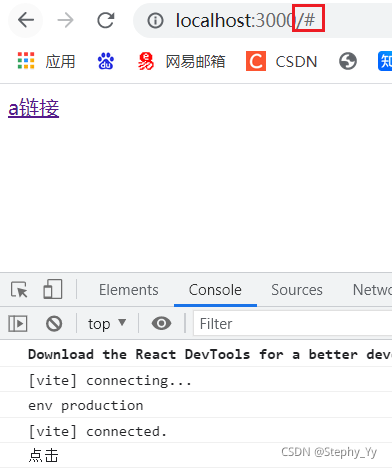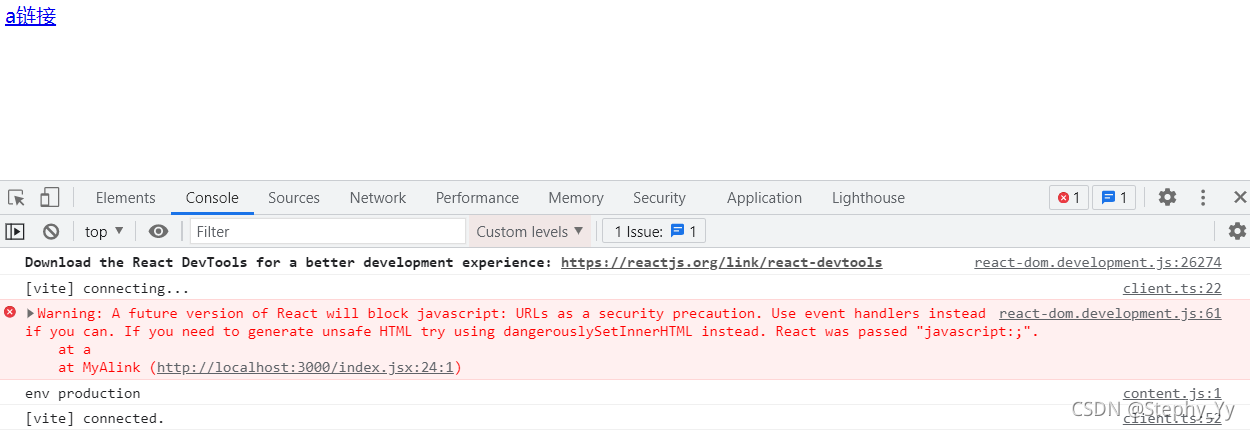事件处理函数绑定
- DOM事件处理
addEventListeneroronclick = function(){}纯小写 - React元素也采用了类似DOM0标准中的事件属性定义的方法 小驼峰
- JSX
<button onClick={ this.doSth }></button> - 直接创建React元素
React.createElement('button',{onClick: { this.doSth }},'按钮'
)
阻止a标签默认行为
- a标签锚点
class MyAlink extends React.Component {handleClick() {console.log('点击')}render() {return <a href="#" onClick={this.handleClick}>a链接</a>}
}
ReactDOM.render(<MyAlink />,document.getElementById('app')
)

- 使用伪协议在React中会报warning
<a href="javascript:;" onClick={this.handleClick}>a链接</a>

- 阻止默认事件 e(React事件对象,并非js原生的e)
class MyAlink extends React.Component {handleClick(e) {e.preventDefault()console.log('点击', e)}render() {return <a href="#" onClick={this.handleClick}>a链接</a>}
}

事件对象
- SyntheticBaseEvent 合成基础事件对象
- 这个SBE是遵守W3C事件对象的规范的,不存在任何的浏览器兼容性问题

React为什么要将事件处理直接绑定在元素上
- React认为事件处理和视图有直接关系,写在一起可以更直观地表述视图与逻辑的关系,便于维护
this指向
- ES6 class模块默认不对事件处理函数进行this的再绑定
class MyButton extends React.Component {handleClick() {console.log('this', this)// this默认undefined}render() {return <button onClick={this.handleClick}>按钮</button>}
}
ReactDOM.render(<MyButton />,document.getElementById('app')
)
function outerClick() {console.log('outher-this', this)// 依然是undefined
}
class MyButton extends React.Component {render() {return <button onClick={outerClick}>按钮</button>}
}
ReactDOM.render(<MyButton />,document.getElementById('app')
)
- DOM0事件
// this指向button
<button onclick="console.log(this)">123</button>
解决this指向 建议使用134
- 在构造器中bind this 隐式传入e
- 在视图中bind this 隐式传入e
- 回调 + 箭头函数 + 方法执行(render函数每次执行时都会创建新的回调)
注意:给子组件的属性传递函数时,由于每次都创建一个回调,子组件每次都接收一个新的函数,可能触发子组件的render 显式传入e - class field写法:class内部的箭头函数
事件对象都在最后一个参数
// 在构造器中bind this
class MyButton extends React.Component {constructor(props) {super(props)this.handleClick = this.handleClick.bind(this)}handleClick() {console.log('this', this)// this指向类MyButton}render() {return <button onClick={this.handleClick}>按钮</button>}
}
// 在视图中bind this
class MyButton extends React.Component {constructor(props) {super(props)}handleClick(e) {// bind方法要使用e,无须传入,是隐式传入的 console.log('this', this, e)// this指向类MyButton}render() {return <button onClick={this.handleClick.bind(this)}>按钮</button>}
}
// 回调 + 箭头函数 + 方法执行
class MyButton extends React.Component {constructor(props) {super(props)}handleClick(e) {// 要使用e则需要传入econsole.log('this', this)// this指向类MyButton}render() {return <button onClick={(e) => this.handleClick(e)}>按钮</button>}
}
- 用在子组件上时,父组件每次render都创建一个新的回调,fn是响应的,会触发子组件的render
render() {return (<div><button onClick={() => this.handleClick()}>按钮</button><Title fn={() => this.doSth} /></div>)}
// class内部的箭头函数
class MyButton extends React.Component {constructor(props) {super(props)}// 实验性写法outerClick = () => {console.log('outher-this', this)// 箭头函数的this是稳定的 指向button}render() {return (<div><button onClick={this.outerClick}>按钮</button></div>)}
}










数据库备份,修改父类的方法)








